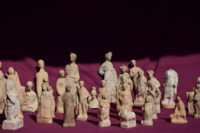 Excavations of the Roman theater in the ancient Hellenistic city of Myra in southwestern Turkey have uncovered a passel of earthenware and terracotta cult figurines. Dozens of figurines were found under a layer silt deposited in the 1st-2nd centuries B.C.
Excavations of the Roman theater in the ancient Hellenistic city of Myra in southwestern Turkey have uncovered a passel of earthenware and terracotta cult figurines. Dozens of figurines were found under a layer silt deposited in the 1st-2nd centuries B.C.
The figurines, that are 2,100 to 2,200 years old included mortal men and women as well as divine figures such as Artemis, Heracles, Aphrodite, Leto and Apollo; they also included figurines depicting a woman and a
child, a boy with a fruit, a horseman and a woman carrying hydria (an ancient Greek water vessel). Because of the “collective coexistence” of the figurines and the fact that the collection included divine figurines, votive plates and incense containers, the researchers think that the figurines may have been brought in from a cult area and thrown here. […]
Some of the statues had partially preserved paint on them. Red, blue and
pink were used “intensely in different shades” in the clothes of the figurines, he said. The inscriptions on the backs of some of the figurines could be the name of a master or workshop. The fact that the team discovered more than 50 terracotta heads that are missing their bodies suggests there are more figurines in the area to be found.
Founded in the 5th century B.C., Myra was one of the largest towns in the 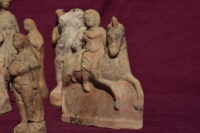 Lycian league (168 B.C. – 43 A.D.) and rose to even higher prominence under Rome. It was the capital of the Roman province of Lycia and its harbor, one of the largest ports on the Mediterranean, was a major center of trade until it silted over in the late 4th century.
Lycian league (168 B.C. – 43 A.D.) and rose to even higher prominence under Rome. It was the capital of the Roman province of Lycia and its harbor, one of the largest ports on the Mediterranean, was a major center of trade until it silted over in the late 4th century.
This past season (June to October 2020) was the 11th consecutive year of excavations at the site. Archaeologists excavated the rooms beneath the Roman theater’s stage, uncovering the ancient orchestra section and remains from a smaller Hellenistic-era theater. The figurines were found scattered among them.
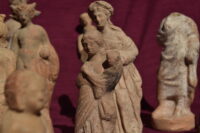
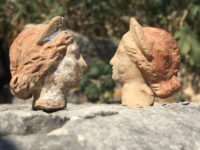
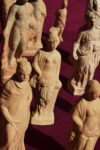
It should also be mentioned that the city of Myra was also home to Santa Claus (“Saint Nick”), a.k.a. Saint Nicholas of Myra, a.k.a. Nicholas the Wonderworker.
The terracotta figurines remind me of the Roman bronze cult figurines, found in Weißenburg in 1979 south to the huge thermal bath of ‘* Castellum Biriciana‘, when allegedly a local teacher wanted to grow his garden asparagus:
commons.wikimedia.org/wiki/Category:Treasure_of_Weißenburg_-_Statues_of_gods
:hattip:
———
*Biriciana is a former Roman Ala castellum, a UNESCO World Heritage Site located near the Upper Germanic-Rhaetian Limes, in the Middle Franconian county of Weißenburg-Gunzenhausen in Germany, cf.:
web.archive.org/web/20071110163719/http://www.antikefan.de/Staetten/Deutschland/limes/biricianca/biriciana.html#thermen
These are absolutely extraordinary. I’ve never heard of figurines like these being used or referenced in any Greco-Roman cultic or religious references. While it’s far too early to conjecture, I must:
* Something like today’s Nativity figurines, used widely in household altars?
* Teaching tools when learning Greek history?
* Game figures, like today’s D&D lead figurines?
The possibilities really are endless.
The ‘Weißenburg Treasure’ mentioned above, as well as the one from ‘Locus Felicis’ in what today is Austria, are commonly interpreted as inventory of a Roman sanctuary, in the latter case a Jupiter Dolichenus temple (~1st to 3rd century AD).
If those cult figurines from Myra are something similar remains to be seen.
:hattip:
en.wikipedia.org/wiki/Jupiter_Dolichenus
amstetten.at/Fotoalben/Jupiter%20Dolichenus/album/slides/20.Gesamtbild_d_Fundes.html (for a slideshow click )
———-
“Jupiter Dolichenus was always addressed in full as Jupiter Optimus Maximus Dolichenus, in Latin epigraphical dative case abbreviated ‘IOM Dolicheno’, or ‘Iovi Optimo Maximo Dolicheno’ in full. […] The cult of Jupiter Dolichenus was a mystery religion whose customs and rituals were restricted to initiates, and it seems that the cult had a particular attraction for members of the military.”
…the ‘Jupiter Dolichenus’ military mystery cult might have parallels in the military ‘Masonic Field Lodges’.
Kalb, for example, is from my village, he went with Lafayette on behalf of the French on two occasions to the future US of A (Kalb died there), and it seems as if they all were attracted by the Masonic ‘mystery cult’, i.e. the French, the British as well as the Revolutionists, but I do not have a proper explanation for it.
Whatever the attraction may have been, maybe they used the cult as some sort of communication channel :confused: